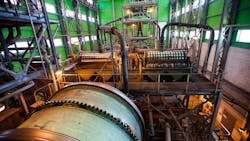Squelch Separator Snafus
Even the lowly separator drum hides hidden subtleties that affect plant operation and reliability.
Separator drums may separate phases by density difference. A light phase rises in the separator, and a heavy phase falls. Gravity acts on the difference in densities between the phases to make the heavy phase fall. Drag force between the phases slows the fall of the heavy phase. The most common version is the vapor-liquid separator. However, liquid-liquid, separators with solids, three-phase and more complex separators still work on the same principle. For a vapor-liquid separator, the droplet velocity down in the gas above the liquid level needs to higher than the velocity of the gas rising. Additionally, in the liquid phase in the bottom, the velocity of the liquid bubble rising must be higher than the liquid velocity moving down for separation to occur.
For this discussion, we’ll use the term particles to refer to the discontinuous phase moving through the continuous phase. That may be either droplets falling through vapor or bubbles rising through liquid. The varying drag force on the particles that retards separation changes with the density difference and the drag coefficient of the particles.
As in all classic fluid-flow problems, the Reynolds number (NRe) of the particles moving through the continuous phase is the starting point for analyzing separator performance. At low NRe (<2), Stokes’ law applies. At these low NRe the drag coefficient is linear with NRe. At high NRe (>500) the drag coefficient on the particles reaches a limiting factor of 0.44.
The Impact of Drum Performance
If separator drums don’t work well, performance impacts can be severe. The wrong phase can contaminate products. Liquid droplets or solid particles can get into the gas phase going to downstream machinery (compressors and turbines) causing erosion, corrosion and catastrophic mechanical damage. Entrained gas bubbles in pump suctions can cause cavitation-like pump damage and poor pump performance. Many other problems can also occur in separator drums.
Despite the consequences of poor drum performance, many engineers don’t fully understand the basic assumptions often built into separator sizing. Basic drum sizing has three major assumptions concerning particle shape, velocity profiles and particle removal performance.
First, nearly every separator is sized assuming a spherical particle. This is often not true with solids. Even with liquids, it is rarely true. Different particle shapes have different cross sections to drag, so the drag coefficient changes. This can significantly change separator performance.
Second, separator sizing generally assumes a smooth velocity for the continuous phase. Depending upon nozzle configurations, velocities, physical properties and vessel sizes, many separators have channeling and recirculation. These internal flow patterns can dramatically increase velocities from the inlet to the outlet and decrease separator performance. Local velocities can also cause re-entrainment at the interface between the bulk phases. One common example of this is vapor jets creating liquid spray when they hit a liquid surface.
Third, conventional separator sizing has a built-in assumption of a minimum particle size that separates in the range of 100–150 microns. Unless special features or criteria are applied during separator sizing, you should expect many particles of less than 100 microns not to be separated.
If your separator is not working as intended or just needs to work better, look at and understand these three elements first. Often this will provide the key to understanding what went wrong or what can be improved.
Generally, spherical particles have the highest drag coefficient at low NRe (<~60) and a lower drag coefficient at high NRe(>~60). The breakpoint between high and low varies with particle shape. The value of 60 for NRe quoted here applies to conventional disc shapes and cylinder shapes. Using spheres as the particle shape assumption gives a conservative (larger than needed) separator sized for small particles and an optimistically (smaller than needed) sized one for large particles. Normally, the plant can’t do much about particle shape in most processes.
Smooth velocities are critical. Internal vanes and projections can help or hurt separator performance depending on their exact layout. Take care to prevent high-velocity impingement on already separated phases. Without vanes, you should expect that inlet gas flows will diverge through a cone with a 30° opening when they enter a vessel. Great care must be taken with liquid entrained in a gas. If the two-phase velocity is high enough, liquid entrainment can shoot all the way across a vessel and create problems by splashing from the vessel walls. If there is any risk of liquid slugs or more than a volume percent of liquid in the feed, momentum breakers must be used to reduce the liquid velocity. In fact, they are often needed at much lower liquid fractions.
Finally, reduce particle fragmentation and increase particle coalescence. A major feature that reduces particle fragmentation is lower inlet velocity. Then, increase particle coalescence. Mist pads are one key way to create larger droplets from smaller droplets. If you have or want to have a mist pad, check at least three things; (1) What is the likely residence time of liquid in the mist pad and will undesired reactions occur? (2) The mass pad can act as a mass-transfer device, and will that affect liquid or vapor composition? And (3) do special features need to be added to prevent liquid re-entrainment from the mist pad?
If you keep the elements of particle shape, local velocity and particle size in mind, you will find they allow you to understand and solve many important separator problems.
About the Author
Andrew Sloley, Plant InSites columnist
Contributing Editor
ANDREW SLOLEY is a Chemical Processing Contributing Editor.

